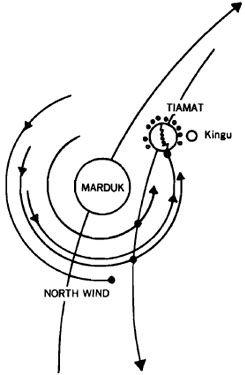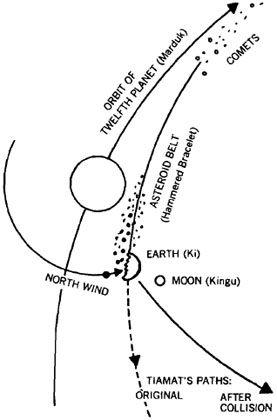The 12th Planet (36 page)
Authors: Zecharia Sitchin
Tags: #Non-Fiction, #Gnostic Dementia, #Fringe Science, #Retail, #Archaeology, #Ancient Aliens, #History

Convene an Assembly to proclaim my Destiny supreme!"
The condition was audacious but simple: Marduk and his "destiny"—his orbit around the Sun—were to be supreme among all the celestial gods. It was then that Gaga, Anshar/Saturn's satellite—and the future Pluto—was loosened from his course:
Anshar opened his mouth,
To Gaga, his Counsellor, a word he addressed....
"Be on thy way, Gaga,
take the stand before the gods,
and that which I shall tell thee
repeat thou unto them."
Passing by the other god/planets, Gaga urged them to "fix your decrees for Marduk." The decision was as anticipated: The gods were only too eager to have someone else go to settle the score for them. "Marduk is king!" they shouted, and urged him to lose no more time: "Go and cut off the life of Tiamat!"
The curtain now rises on Act IV, the celestial battle.
The gods have decreed Marduk's "destiny"; their combined gravitational pull has now determined Marduk's orbital path so that he can go but one way—toward a "battle," a collision with Tiamat.
As befits a warrior, Marduk armed himself with a variety of weapons. He filled his body with a "blazing flame"; "he constructed a bow ... attached thereto an arrow ... in front of him he set the lightning"; and "he then made a net to enfold Tiamat therein." These are common names for what could only have been celestial phenomena—the discharge of electrical bolts as the two planets converged, the gravitational pull (a "net") of one upon the other.
But Marduk's chief weapons were his satellites, the four "winds" with which Uranus had provided him when Marduk passed by that planet: South Wind, North Wind, East Wind, West Wind. Passing now by the giants, Saturn and Jupiter, and subjected to their tremendous gravitational pull, Marduk "brought forth" three more satellites—Evil Wind, Whirlwind, and Matchless Wind.
Using his satellites as a "storm chariot," he "sent forth the winds that he had brought forth, the seven of them." The adversaries were ready for battle.
The Lord went forth, followed his course;
Towards the raging Tiamat he set his face....
The Lord approached to scan the innerside of Tiamat–
The scheme of Kingu, her consort, to perceive.
But as the planets drew nearer each other, Marduk's course became erratic:
As he looks on, his course becomes upset,
His direction is distracted, his doings are confused.
Even Marduk's satellites began to veer off course:
When the gods, his helpers,
Who were marching at his side,
Saw the valiant Kingu, blurred became their vision.
Were the combatants to miss each other after all?
But the die was cast, the courses irrevocably set on collision. "Tiamat emitted a roar" ... "the Lord raised the flooding storm, his mighty weapon." As Marduk came ever closer, Tiamat's "fury" grew; "the roots of her legs shook back and forth." She commenced to cast "spells" against Marduk—the same kind of celestial waves Ea had earlier used against Apsu and Mummu. But Marduk kept coming at her.
Tiamat and Marduk, the wisest of the gods,
Advanced against one another;
They pressed on to single combat,
They approached for battle.
The epic now turns to the description of the celestial battle, in the aftermath of which Heaven and Earth were created.
The Lord spread out his net to enfold her;
The Evil Wind, the rearmost, he unleashed at her face.
As she opened her mouth, Tiamat, to devour him—
He drove in the Evil Wind so that she close not her lips.
The fierce storm Winds then charged her belly;
Her body became distended; her mouth had opened wide.
He shot there through an arrow, it tore her belly;
It cut through her insides, tore into her womb.
Having thus subdued her, her life-breath he extinguished.
Here, then, (Fig. 107) is a most original theory explaining the celestial puzzles still confronting us. An unstable solar system, made up of the Sun and nine planets, was invaded by a large, comet-like planet from outer space. It first encountered Neptune; as it passed by Uranus, the giant Saturn, and Jupiter, its course was profoundly bent inward toward the solar system's center, and it brought forth seven satellites. It was unalterably set on a collision course with Tiamat, the next planet in line.
But the two planets did
not
collide, a fact of cardinal astronomical importance: It was the satellites of Marduk that smashed into Tiamat, and not Marduk himself. They "distended" Tiamat's body, made in her a wide cleavage. Through these fissures in Tiamat, Marduk shot an "arrow," a "divine lightning," an immense bolt of electricity that jumped as a spark from the energy-charged Marduk, the planet that was "filled with brilliance." Finding its way into Tiamat's innards, it "extinguished her life-breath"—neutralized Tiamat's own electric and magnetic forces and fields, and "extinguished" them.
The first encounter between Marduk and Tiamat left her fissured and lifeless; but her final fate was still to be determined by future encounters between the two. Kingu, leader of Tiamat's satellites, was also to be dealt with separately. But the fate of the other ten, smaller satellites of Tiamat was determined at once.
After he had slain Tiamat, the leader,
Her band was shortered, her host broken up.
The gods, her helpers who marched at her side,
Trembling with fear,
Turned their backs about so as to save and preserve their lives.
Can we identify this "shortered ... broken" host that trembled and "turned their backs about"—reversed their direction?
By doing so we offer an explanation to yet another puzzle of our solar system—the phenomenon of the comets. Tiny globes of matter, they are often referred to as the solar system's "rebellious members," for they appear to obey none of the normal rules of the road. The orbits of the planets around the Sun are (with the exception of Pluto) almost circular; the orbits of the comets are elongated, and in most instances very much so—to the extent that some of them disappear from our view for hundreds or thousands of years. The planets (with the exception of Pluto) orbit the Sun in the same general plane; the comets' orbits lie in many diverse planes. Most significant, while all the planets known to us circle the Sun in the same counterclockwise direction, many comets move in the reverse direction.

Fig. 107.
THE CELESTIAL BATTLE
A. Marduk's "winds" colliding with Tiamat and her "host" (led by Kingu).
Astronomers are unable to say what force, what event created the comets and threw them into their unusual orbits. Our answer: Marduk. Sweeping in the reverse direction, in an orbital plane of his own, he shortered, broke the host of Tiamat into smaller comets and affected them by his gravitational pull, his so-called net:
Thrown into the net, they found themselves ensnared....
The whole band of demons that had marched on her side
He cast into fetters, their hands he bound....
Tightly encircled, they could not escape.
After the battle was over, Marduk took away from Kingu the Tablet of Destinies (Kingu's independent orbit) and attached it to his own (Marduk's) breast: his course was bent into permanent solar orbit. From that time on, Marduk was bound always to return to the scene of the celestial battle.
Having "vanquished" Tiamat, Marduk sailed on in the heavens, out into space, around the Sun, and back to retrace his passage by the outer planets: Ea/Neptune, "whose desire Marduk achieved," Anshar/Saturn, "whose triumph Marduk established." Then his new orbital path returned Marduk to the scene of his triumph, "to strengthen his hold on the vanquished gods," Tiamat and Kingu.
As the curtain is about to rise on Act V, it will be here—and only here, though this has not hitherto been realized—that the biblical tale of Genesis joins the Mesopotamian "Epic of Creation"; for it is only at this point that the tale of the Creation of Earth and Heaven really began.
Completing his first-ever orbit around the Sun, Marduk "then returned to Tiamat, whom he had subdued."
The Lord paused to view her lifeless body.
To divide the monster he then artfully planned.
Then, as a mussel, he split her into two parts.
Marduk himself now hit the defeated planet, splitting Tiamat in two, severing her "skull," or upper part. Then another of Marduk's satellites, the one called North Wind, crashed into the separated half. The heavy blow carried this part—destined to become Earth—to an orbit where no planet had been orbiting before:
The Lord trod upon Tiamat's hinder part;
With his weapon the connected skull he cut loose;
He severed the channels of her blood;
And caused the North Wind to bear it
To places that have been unknown.
Earth had been created!
The lower part had another fate: on the second orbit, Marduk himself hit it, smashing it to pieces (Fig. 108):
The [other] half of her he set up as a screen for the skies:
Locking them together, as watchmen he stationed them....
He bent Tiamat's tail to form the Great Band as a bracelet.
The pieces of this broken half were hammered to become a "bracelet" in the heavens, acting as a screen between the inner planets and the outer planets. They were stretched out into a "great band." The asteroid belt had been created.

